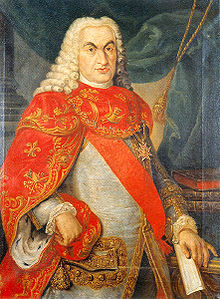- Maria Carolina of Austria
-
Maria Carolina of Austria 
Queen consort of Naples Tenure 12 May 1768 – 23 January 1799
13 June 1799 – 30 March 1806Queen consort of Sicily Tenure 12 May 1768 – 8 September 1814 Spouse Ferdinand IV of Naples Issue Maria Theresa, Holy Roman Empress
Maria Luisa, Grand Duchess of Tuscany
Francis I of the Two Sicilies
Maria Christina, Queen of Sardinia
Maria Amalia, Queen of the French
Maria Antonia, Princess of Asturias
Leopold, Prince of SalernoFull name Maria Carolina Louise Josepha Johanna Antonia House House of Habsburg-Lorraine
House of BourbonFather Francis I, Holy Roman Emperor Mother Maria Theresa of Austria Born 13 August 1752
Schonbrunn Palace, Vienna, AustriaDied 8 September 1814 (aged 62)
Hetzendorf Palace, Vienna, AustriaBurial Imperial Crypt, Vienna Maria Carolina of Austria (German: Maria Karolina von Österreich; Italian: Maria Carolina d'Austria; 13 August 1752 – 8 September 1814) was Queen of Naples and Sicily as the wife of King Ferdinand IV & III. As de facto ruler of her husband's kingdoms, Maria Carolina oversaw the promulgation of many reforms, including the revocation of the ban on Freemasonry, the enlargement of the navy under her favourite, John Acton, 6th Baronet, and the expulsion of Spanish influence. She was a proponent of enlightened absolutism until the advent of the French Revolution, when, in order to prevent its ideas gaining currency, she made Naples a police state.
Born an Austrian archduchess, the thirteenth child of Empress Maria Theresa and Emperor Francis I, she married Ferdinand as part of an Austrian alliance with Spain, where Ferdinand's father was King. Following the birth of a male heir in 1775, Maria Carolina was admitted to the Privy Council. Thereafter, she dominated it until 1812, when she was sent back to Vienna. Like her mother, Maria Carolina took pains to make politically advantageous marriages for her children. A patron, Maria Carolina promoted Naples as a centre of the arts, patronising painters Jacob Philipp Hackert and Angelica Kauffman and academics Gaetano Filangieri, Domenico Cirillo and Giuseppe Maria Galanti. Maria Carolina, abhorred by her sister Marie Antoinette's treatment by the French, allied Naples with Britain and Austria during the Napoleonic and French Revolutionary Wars. As a result of a failed Neapolitan invasion of French-occupied Rome, she fled to Sicily with her husband in December 1798. One month later, the Parthenopean Republic was declared, which repudiated Bourbonic rule in Naples for six months. Deposed as Queen of Naples for a second time by French forces, in 1806, Maria Carolina died in Vienna in 1814, a year before her husband's restoration to Naples.
Contents
Early life
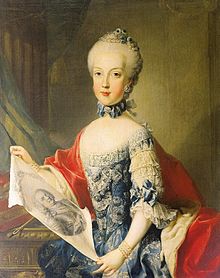 Archduchess Maria Carolina holding a portrait of her father, Francis I, Holy Roman Emperor.
Archduchess Maria Carolina holding a portrait of her father, Francis I, Holy Roman Emperor.
Born on 13 August 1752 at the Schönbrunn Palace, Vienna, Maria Carolina was the thirteenth and tenth surviving child of Francis I, Holy Roman Emperor and Maria Theresa of Austria, Queen of Hungary and Bohemia and ruler of the Habsburg dominions. Her godparents were King Louis XV of France and his Polish-born queen, Marie Leczinska.[1] Maria Carolina was the daughter who resembled her mother most. Maria Carolina formed a very close bond with her youngest sister, Maria Antonia.[2] From very early on they shared the same governess Countess Lerchenfeld. A testament to their closeness is the fact that when one caught an illness, the other did, too.[2] In August 1767, Maria Theresa separated the two girls, hitherto raised together under the auspices of Countess Marie von Brandis, because of their bad behaviour.[3] Soon after, in October of the same year, Maria Carolina's sister Maria Josepha, destined to marry Ferdinand IV of Naples as part of an alliance with Spain, died during a smallpox epidemic.[4] Anxious to save the Austro-Spanish alliance, Charles III of Spain, father of Ferdinand IV, requested one of Maria Josepha's sisters as a replacement.[5][6] The Empress offered the court of Madrid, negotiating on behalf of that of Naples, Maria Amalia or Maria Carolina.[7] Because Maria Amalia was five years older than his son, Charles III opted for the latter.[7] Maria Carolina reacted badly to her engagement, crying, entreating and saying that Neapolitan marriages were unlucky.[7] Her objections, however, did not delay her preparation for her new role as Queen of Naples by the Countess of Lerchenfeld.[8] Nine months later, on 7 April 1768, Maria Carolina married Ferdinand IV of Naples by proxy, her brother Ferdinand representing the bride-groom.[9]
Queen
Fall of Tanucci
The sixteen-year-old Queen of Naples journeyed at leisure from Vienna to Naples, making stops at Mantua, Bologna, Florence and Rome on the way.[10][11][12] She entered the Kingdom of Naples on 12 May 1768, disembarking at Terracina, where she took leave of her native attendants.[11] From Terracina, she and her remaining suite, comprising her brother the Grand Duke of Tuscany and his wife Maria Luisa of Spain, ventured to Poztella, where she met her husband, whom she found "very ugly".[13] To the Countess of Lerchenfeld, she wrote, "I love him only out of duty...."[13] Ferdinand, too, was not taken with her, declaring, after their first night together, "She sleeps like the dead and sweats like a pig."[14]
Maria Carolina's dislike of her husband, however, did not get in the way of her bearing children, as her most important wifely duty was to perpetuate the dynasty. In total, Maria Carolina bore Ferdinand eighteen children, of whom seven survived to adulthood including his successor, Francis I, the last Holy Roman Empress, a Grand Duchess of Tuscany, the last Queen of the French and a Princess of Asturias.
Ferdinand, having received a lacklustre education from the Prince of San Nicandro, lacked the ability to rule, relying completely on his father Charles III of Spain's[note 1] counsel, communicated by Bernardo Tanucci.[16] Pursuant to Empress Maria Theresa's instructions, Maria Carolina gained Ferdinand's trust by feigning interest in his favourite activiy—hunting.[17] With it, she obtained a back-door to the administration of the state, only to be fully realised by the birth of an heir in 1775, with her admission to the Privy Council.[17][18] Until then, Maria Carolina presided over the rejuvenation of Neapolitan court life, largely neglected since the advent of her husband's regency.[19] Academics Gaetano Filangieri, Domenico Cirillo and Giuseppe Maria Galanti frequented her salon, among others.[20]
Tanucci's fall from grace came about over an argument with Maria Carolina regarding Freemasonry, of which she was an adherent.[17] Acting on orders from Charles III, Tanucci revived a law from 1751 banning Freemasonry in response to the discovery of a masonic lodge among the royal regiment.[17] Angered, the Queen expressed to Charles III her opinion that Tanucci was ruining the country through the medium of a letter written by her husband, thus making it look as if it was his idea.[21] Resigned to the Queen's wishes, Ferdinand dismissed Tanucci in October 1776, causing a rift with his father.[22] The appointment of Tanucci's successor, the Marquis of Sambuca, Maria Carolina's powerless puppet, represented the end of Spanish influence in Naples, hitherto virtually a province of that country.[23][24] Maria Carolina proceeded to alienate large swaths of the nobility by substituting the influence of Spain for that of Austria.[25] Her unpopularity among the nobility was increased by her attempts to curb their prerogative.[25]
Acton and the military
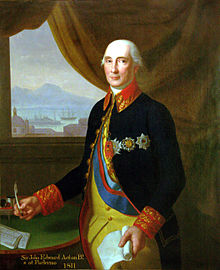 John Acton, 6th Baronet, Maria Carolina's favourite, from a painting by Emanuele Napoli.
John Acton, 6th Baronet, Maria Carolina's favourite, from a painting by Emanuele Napoli.
Without Tanucci in government, the Queen alone ruled Naples and Sicily, assisted by her French-born, English favourite, John Acton, 6th Baronet, from 1778 onwards.[26] Acting on her brother the Holy Roman Emperor Joseph II's advice, Maria Carolina and Acton revamped the Neapolitan navy, hitherto neglected, opening 4 marine colleges and commissioning 150 ships of various sizes.[26][27] The merchant navy, too, was augmented by trade pacts with Russia and Genoa.[27] Charles III, having declared war on Great Britain in alliance with America, was angered by Acton's appointment to the Ministry of War and of Marine because he felt his Spanish candidate, Don Antonio Otero, was more worthy of such a high government post by virtue of the fact he wasn't English.[28] Maria Carolina once again replied using a letter written by the King, expounding to Charles III that Acton, the son of a French woman, was not English and that he was appointed before Spanish hostilities with Britain broke out.[28] Charles's attacks against Acton only served to endear the latter more to the Queen, who proceeded to appoint him Field-Marshal.[28] Acton's reforms were not restricted to the expansion of the navy; at the same time, he cut the expenditure of his department by 500,000 ducats and invited foreign drill-sergeants and officers to fill vacancies in the army.[27][29] Acton and Maria Carolina were seen to have become so close by 1782 that, according to the Sardinian ambassador in Naples, people falsely believed they were lovers.[30] That the rumour was untrue was not known to the King, who tried several times to "surprise you together" and threatened to kill them both in a rage.[31] In response, Maria Carolina set spies on her husband, but a reconciliation was soon achieved.[31] As part of this rapprochment, Acton went to live in Castellamare, but returned to Naples three times a week to see the Queen.[31]
Artistic patronage and the death of Charles III
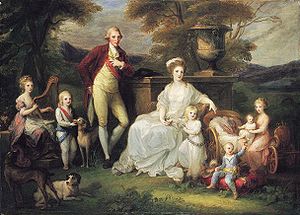 The Royal Family of Naples by Angelica Kauffman. This portrait represents a break with typical depictions of the Bourbons, incorporating an Arcadian landscape and simple poses.[32]
The Royal Family of Naples by Angelica Kauffman. This portrait represents a break with typical depictions of the Bourbons, incorporating an Arcadian landscape and simple poses.[32]
Maria Carolina patronised German-Swiss artists, foremostly Angelica Kauffman, who famously painted the Queen's family in an informal garden setting in 1783, and gave her daughters lessons in drawing.[33] Maria Carolina showered Kauffman with gifts, but she preferred the artistic circles in Rome to Naples.[34] The Queen's patronage was not restricted to portrait painters: she allotted landscape painter Jacob Philipp Hackert a wing of the palace at Francavilla.[34] Like Kauffman, he gave lessons to the Queen's children and enjoyed her confidence.[35] On recommendation from Hackert, the King and Queen restored the statues of Palazzo Farnese and brought them to Naples.[36] In 1784, the Queen established the philanthropic San Leucio colony, a village with its own unique laws and customs whose sole object it was to weave silk.[37]
In 1788, with the death of King Charles III, Neapolitan-Spanish relations improved.[38] The new King, Charles IV, was eager to be on good terms with his brother, the King of Naples, sending the Spanish fleet to salute to him.[39] To consolidate their reconciliation, Charles IV proposed that his daughter marry the King and Queen's eldest son, the Duke of Calabria.[39] While the King supported the match, Maria Carolina shunned it.[39] Like her mother, she had carefully chosen the prospective husbands and wives of her children, matches that were to cement political alliances of her choosing.[40] The death of the Queen's nephew Crown Prince Francis of Austria's wife, Duchess Elisabeth of Württemberg, afforded her an opportunity to fulfil her marital ambitions.[41] Her daughters Maria Theresa and Luisa married Crown Prince Francis and Ferdinand III, Grand Duke of Tuscany, respectively, during the Neapolitan royal family's visit to Vienna in 1790.[42]
End of enlightened absolutism
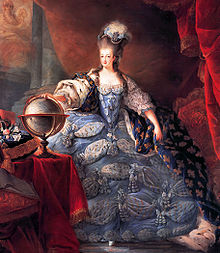 Marie Antoinette, Queen of France, here depicted by Jean-Baptiste Gautier Dagoty, was Maria Carolina's favourite sister. It was as a response to her treatment by the French that Maria Carolina allied Naples with Britain during the Great French War.[43]
Marie Antoinette, Queen of France, here depicted by Jean-Baptiste Gautier Dagoty, was Maria Carolina's favourite sister. It was as a response to her treatment by the French that Maria Carolina allied Naples with Britain during the Great French War.[43]
Maria Carolina was anxious to improve Neapolitan-Papal relations, which had deteriorated owing to arguments with Pope Pius VI over ecclesiastical laws and the investiture and choice of bishops.[44] Consequently, Naples had stopped paying its annual tribute of 7,000 ducats.[note 2][44] Therefore, Maria Carolina arranged a meeting with the Pope.[44] To emphasise their desire to see him, the King and Queen arrived in Rome, en route to Naples from Vienna, earlier than expected, where they were greeted by Pius VI in a private audience.[45] The Pope agreed to cede to the King the right of appointing bishops to vacant sees.[45] Thus, because the King and Queen had not made any concessions in return, the prestige of Naples was augmented.[46] On leaving, Maria Carolina was presented with the Golden Rose, a great mark of Papal favour.[46]
The return from Vienna marked a new epoch in the politics of Naples.[47] Alarmed by developments in France, especially in regards to her favourite sister, Marie Antoinette[note 3], Maria Carolina ended her experiment in enlightened absolutism and started on a reactionary course.[49] She rejected the French Revolution and was determined to prevent its ideology gaining prevalence in Naples.[50] She did this by sub-dividing Naples into twelve police wards, controlled by government-appointed commissioners, replacing the popularly-elected alderman system.[51] The effectiveness of the wards was increased by the creation of a secret police force, which had in its pay spies of every class.[51] It was through her secret police that Maria Carolina learned of her substantial decline in popularity among all classes of society.[52]
In an attempt to please Great Britain, with a military alliance in mind, the Queen deigned to meet the wife of the English ambassador, Emma Hamilton, in audience, despite the fact that the British Queen, Charlotte of Mecklenburg-Strelitz, had not yet received her.[note 4][53] However, they soon struck up a friendship, Emma singing duets with the King and dining privately with the royal family.[54] The Queen, whom Emma thought "most excellent and strictly good and upright", was drawn closer to Emma by her willingness to betray Britain's diplomatic secrets.[54]
The Sémonville affair and the First Coalition
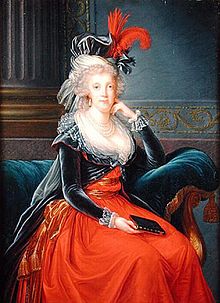 Maria Carolina, as she appeared in 1791, in a painting by Élisabeth-Louise Vigée-Le Brun. The resemblance with her sister Marie Antoinette is notorious.
Maria Carolina, as she appeared in 1791, in a painting by Élisabeth-Louise Vigée-Le Brun. The resemblance with her sister Marie Antoinette is notorious.
King Louis XVI of France and Queen Marie Antoinette were arrested on 10 August 1792.[55] Hence, the Neapolitan government refused to recognise French diplomatist Baron Armand de Mackau's recently-arrived legation.[55] Queen Maria Carolina was so horrified at what had happened at the Tuileries that day that she almost broke off relations with France altogether.[56] The King and Queen's prevarication of Mackau's requests to be recognised as a representative of the French Republic[note 5] caused tension with that country.[58] John Acton, now Prime Minister of Naples, allayed Maria Carolina's fervent desire to go to war with France and tried to placate Mackau until he could rely on British military support.[58] His plan, however, back-fired when the French government intercepted a letter detailing how he sabotaged the diplomatic mission of Huguet de Sémonville to the Ottoman Empire.[59] When France started making preparations for war in November to avenge this insult, the King and Queen finally capitulated and begrudged recognition to Mackau and the Republic.[59] However, the national assembly had already sent 9 ships under Admiral La Touche to seek redress, which arrived on 17 December in Naples.[60] La Touche stipulated that, if Acton did not apologise to him in person for the Sémonville affair, he would lay waste to Naples within an hour.[60] The Queen's decision to accede to La Touche's demands earned her the criticism of some Neapolitan historians, like General Colletta, who over-look the fact that Naples was unable to mount a defence at the time as the navy was not mobilised.[60]
Maria Carolina's preventatives against Jacobinism were rendered useless in the face of the subversive actives of La Touche's fleet, which was obliged to return to Naples shortly after leaving by a storm.[61] The French sailors, "republican agents", were allowed to land on this occasion, inculcating their anti-monarchical sentiments in the Neapolitans.[61] Upon La Touche's departure, on 29 January 1793, Maria Carolina launched an ineffective offensive against Neapolitan radicals, allowing the most dangerous schemers to escape justice.[62] Why the offensive failed can be explained by the fact that her chief of police, Luigi de' Medici, was secretly a radical himself.[62] Concurrently, Maria Carolina arranged a treaty of alliance with Great Britain, on whom France had latterly declared war.[63] By this treaty, Naples was to contribute four men-of-war, four frigates and four smaller ships, along with six thousand soldiers, to protect commerce in the Mediterranean Sea.[63] In August 1793, following the Siege of Toulon, Naples joined the First Coalition, comprising Great Britain, Russia, Austria, Prussia, Spain, Portugal and Savoy-Sardinia, against France.[64][65]
Italian campaign
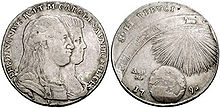 The effigies of Maria Carolina and her husband on a 1791 Neapolitan piastra.
The effigies of Maria Carolina and her husband on a 1791 Neapolitan piastra.
The execution of Marie Antoinette in October 1793 breathed a new lease of life into the Queen's counter-revolution.[66] Maria Carolina was so horrified by that event that she refused to speak French, "that monstrous language", and banned the "inflammatory" philosophical works of Galanti and Filangeri, who had hitherto enjoyed the Queen's patronage.[67] In 1794, following the discovery of a Jacobin plot to overthrow the government, Maria Carolina ordered Medici to suppress the Freemasons, of which she was once an adherent, believing they were partaking in treasonable activities with the French.[66] The army was kept perpetually mobilised in case of sudden attack, occasioning a huge increase in taxation.[68] Fearing for the safety of her family, Maria Carolina employed food-testers and switched the royal families' apartments on a daily basis.[69] What compelled Maria Carolina to do this was the general terror reigning throughout the city, in which "nobody was safe".[69]
The cessation of Franco-Spanish hostilities in the summer of 1795 gave Napoleon Bonaparte, a Corsican general in the French army, the opportunity to focus on France's Italian Campaign.[70] Bonaparte's successes in Northern Italy[note 6] compelled Maria Carolina to sue for peace, under which Naples had to pay to France a war indemnity of 8 million francs.[72] However, neither country intended to observe this treaty in the long-term.[72] The marriage of her eldest son, the Duke of Calabria, to Archduchess Maria Clementina of Austria in 1797 offered Maria Carolina a brief respite from the affairs of war, which had taken a toll on her health.[73] Maria Carolina entered a secret defensive alliance with Austria on 20 May 1798, in response to France's occupation of the Papal States, which shared a border with Naples.[74] After assisting in the British victory at the Battle of the Nile, the Queen decided to join the Second Coalition against France;[75] Austria sent General Mack to take command.[75] War council meetings, comprising the Queen, the King, Mack, Sir William Hamilton, the English ambassador, and Admiral Nelson, the victor of the Nile, were held in the Palace of Caserta.[75] They decided to invade the Roman Republic[note 7], a French puppet state.[77]
Escape and Creation of the Parthenopean Republic
The enter of the Kingdom of Naples and Sicily to the Second Coalition was the excuse of Napoleon to act. The French General Jean Étienne Championnet succeeded it rapidly, and in January 1799 he occupied Naples and forced the royal family to escape to Sicily. In the Sicilian exile Maria Carolina continue his politics towards Naples.
On 24 January 1799 was proclamed in Naples the Parthenopean Republic by the French troops led by General Championnet. The chosen name (after Parthenope, an ancient Greek colony who existed on the site of the future city of Naples) was an intent of the Frenchs to obtain the beneplacit of the Neapolitan people. During the republican period, a government was installed with Ercole D'Agnese as elected President, the press freedom was proclaimed, and were prepare future reforms. However, after only 6 months, the young republic ended when the Sanfedisti, the army leaded by Cardinal Fabrizio Ruffo, attacked and invaded Naples (21 June 1799). The collapse of the republic was largely due to the English fleet, which had supplied the royal army with weapons. Again, was Admiral Nelson who successfully defeated the Frenchs in the summer of 1799 from Naples and Sicily and to secure the throne for the Royal couple.
In June 1800 Maria Carolina traveled with her three unmarried daughters, her younger son Leopoldo, and accompanied by William and Emma Hamilton and Nelson over Livorno, Florence, Trieste and Laibach to Vienna, where she arrived two months later. Maria Carolina stayed two years in her homeland, where she arranged for her children advantageous marriages. In the family circle, she spent most time with her favorite grandchild, Archduchess Marie Louise of Austria, who later became in the wife of her arch-enemy Napoleon.
Second Escape, Exile and Death
After her stay in Vienna, Maria Carolina returned to Naples on 17 August 1802. The European states were concern for Napoleon's growth of power, who reached his peak with his Imperial coronation on on 18 May 1804. By 1805 Italy was again the center of interest of the now Emperor, who was crowned with a crown with the inscription Rex totius Italiae. From then on, events came quickly and Maria Carolina was surprised by the news of the defeat of Austria in the Battle of Austerlitz (2 December 1805).
Napoleon didn't hesitate now to conquer Naples and at first his brother Joseph Bonaparte, and four years later his brother Joachim Murat were sit on the throne of Naples. The royal family was forced to flee in February 1806 to Sicily. The refugees counted in their exile with the help of England, but after the death of Admiral Nelson in the Battle of Trafalgar (21 October 1805), they developed more and more aversion to Maria Carolina, and finally in 1813, when her husband essentially (but not officially) abdicated, appointing their son Francis regent, which deprived her of any political influence, the Queen was forced to leave Sicily and return to Vienna.
Still on the journey she received the news of Napoleon's defeat at the Battle of Leipzig on 19 October 1813. After a long journey through Constantinople, Odessa, Lviv and Budapest, Maria Carolina finally arrived in Vienna in January 1814, where she began negotiations with Prince Metternich and her nephew Emperor Francis I of Austria with the purpose of her restoration in the Neapolitan throne. However, this never happened: Maria Carolina died on 8 September at the consequence of a stroke, without seeing the final exile of Napoleon in the Island of St. Helena and the restoration of her husband in the Congress of Vienna. Her maid found the Queen in a sea of letters lying dead on the floor.
Maria Carolina was buried in the Imperial Crypt in Vienna; her parents are also buried there.
Issue
Children of Ferdinand IAncestry
Notes
- ^ Charles III was King of Naples and Sicily from 1734 until 1759, when his half-brother, Ferdinand VI, died.[15]
- ^ The Kingdom of Naples was nominally a Papal fief.
- ^ In Rome, Maria Carolina met the Mesdames de France, the last two surviving daughters of King Louis XV, who had sought refuge from the turmoil engulfing France there.[48] From them, Maria Carolina learned of her sister's maltreatment at the hands of the French.[48]
- ^ At the time, there was a convention that disbarred women from being received by a foreign sovereign if they had not been received by their native one.[53]
- ^ The French monarchy had just been abolished, on 21 September 1792.[57]
- ^ Napoleon had conquered Parma, Modena, Lombardy and the main fortresses of Piedmont in rapid succession.[71]
- ^ France had replaced the Papal States with a republic in February 1798.[76]
References
Citations
- ^ Lever, p 315.
- ^ a b Fraser, p 27.
- ^ Fraser, p 38.
- ^ Crankshaw, p 274.
- ^ Acton, p 126.
- ^ Bearne, p 57.
- ^ a b c Bearne, p 60.
- ^ Bearne, p 62.
- ^ Bearne, p 66.
- ^ Acton, p 129.
- ^ a b Acton, p 130.
- ^ Bearne, p 67.
- ^ a b Bearne, p 71.
- ^ Acton, p 131.
- ^ Jones, p 243.
- ^ Acton, p 114.
- ^ a b c d Acton, p 172.
- ^ Bearne, p 78.
- ^ Bearne, p 80.
- ^ Bearne, p 81.
- ^ Acton, p 175.
- ^ Acton, pp. 175 - 176
- ^ Bearne, p 84.
- ^ Acton, p 176.
- ^ a b Bearne, p 174.
- ^ a b Acton, p 181.
- ^ a b c Acton, p 189.
- ^ a b c Acton, p 188.
- ^ Bearne, p 102.
- ^ Acton, p 190.
- ^ a b c Bearne, p 104.
- ^ Tarabra, p 203.
- ^ Acton, p 214.
- ^ a b Acton, p 215.
- ^ Acton, p 216.
- ^ Acton, p 217.
- ^ Bearne, pp. 124 - 125.
- ^ Bearne, p 112.
- ^ a b c Bearne, p 113.
- ^ Bearne, p 114.
- ^ Acton, p 229.
- ^ Wheatcroft, p 238.
- ^ Jackson, pp. 260 - 261.
- ^ a b c Bearne, p 127.
- ^ a b Acton, p 232.
- ^ a b Acton, p 233.
- ^ Bearne, p 138.
- ^ a b Bearne, p 128.
- ^ Bearne, p 142.
- ^ Acton, p 237.
- ^ a b Bearne, p 143.
- ^ Bearne, p. 172
- ^ a b Acton, p 241.
- ^ a b Acton, p 242.
- ^ a b Bearne, p 145.
- ^ Bearne, p 161.
- ^ Lever, p 285.
- ^ a b Acton, p 245.
- ^ a b Acton, p 246.
- ^ a b c Bearne, p 164.
- ^ a b Acton, p 251.
- ^ a b Acton, p 256.
- ^ a b Bearne, p 191.
- ^ Acton, p 258.
- ^ Bearne, p 192.
- ^ a b Davis, p 76.
- ^ Acton, p 262.
- ^ Davis, p 77.
- ^ a b Bearne, p 221.
- ^ Acton, p 279.
- ^ Acton, p 280.
- ^ a b Bearne, p 236.
- ^ Bearne, p 238.
- ^ Acton, p 300.
- ^ a b c Bearne, p 246.
- ^ Encyclopaedia Britannica. "Roman Republic". britannica.com. http://www.britannica.com/EBchecked/topic/507900/Roman-Republic. Retrieved 4 May 2010.
- ^ Acton, p 308.
Bibliography
- Acton, Harold (1956). Bourbons of Naples. Methuen & Co.: London.
- Bearne, Catherine Mary (1907). A Sister of Marie Antoinette: The Life-Story of Maria Carolina, Queen of Naples. T. Fisher Unwin: London
- Crankshaw, Edward (1969). Maria Theresa. Longman Publishers: London.
- Davis, John Anthony (2006). Naples and Napoleon: southern Italy and the European revolutions (1780–1860). Oxford University Press: Oxford. ISBN 0-19-820755-7
- Fraser, Antonia (2002). Marie Antoinette: The Journey. Phoenix: London. ISBN 978-0-7538-1305-8
- Jackson, Gudia M (2000). Women Rulers Throughout the Ages: An Illustrated Guide. Abc-Clio: Santa Barbara. ISBN 1851093397
- Jones, Colin (2002). The Great Nation: France from Louis XV to Napoleon. Columbia University Press: New York. ISBN 0-231-12882-7
- Lever, Evelyn (2001). Marie Antoinette: The Last Queen of France. Judy Piatkus: London. ISBN 0-7499-2194-3
- Nagel, Susan. (2008). Marie Thérèse: The Fate of Marie Antoinette's Daughter. Bloosmbury: New York. ISBN 978-0-7475-8159-8
- Tarabra, Daniela (2008). European Art of the Eighteenth Century. The J. Paul Getty Museum: Los Angeles. ISBN 978-0-89236-921-8
- Vernon, Mrs HM. (1909). Italy: From 1494 to 1790. Cambridge University Press: London.
- Vovk, Justin C. (2010). In Destiny's Hands: Five Tragic Rulers, Children of Maria Theresa. iUniverse: Bloomington, Ind. ISBN 978-1-45020-081-3
- Wheatcroft, Andrew (1996). The Habsburgs: Embodying Empire. Penguin Books: London. ISBN 978-0-14-023634-7
External links
 Media related to Maria Carolina of Austria at Wikimedia CommonsMaria Carolina of AustriaHouse of Habsburg-LorraineBorn: 13 August 1752 Died: 8 September 1814
Media related to Maria Carolina of Austria at Wikimedia CommonsMaria Carolina of AustriaHouse of Habsburg-LorraineBorn: 13 August 1752 Died: 8 September 1814Italian royalty Vacant Title last held byMaria Amalia of SaxonyQueen consort of Naples
12 May 1768 – 23 January 1799Vacant Queen consort of Sicily
12 May 1768 – 8 September 1814Vacant Title next held byMaría Isabella of Spain
as Queen consort of the Two SiciliesVacant Queen consort of Naples
13 June 1799 – 30 March 1806Vacant Title next held byJulie ClaryAustrian archduchesses by birth 1st generation none2nd generation Archduchess Helena · Kunigunde, Duchess of Bavaria3rd generation 4th generation Eleanor, Queen of France* · Isabella, Queen of Denmark and Norway* · Maria, Queen of Hungary* · Catherine, Queen of Portugal*5th generation Elisabeth, Queen of Poland · Maria, Holy Roman Empress* · Anna, Duchess of Bavaria · Archduchess Isabella* · Maria, Duchess of Jülich-Cleves-Berg · Archduchess Magdalena · Catherine, Queen of Poland · Eleanor, Duchess of Mantua · Archduchess Margaret · Joan, Princess of Portugal* · Barbara, Duchess of Ferrara · Archduchess Ursula · Archduchess Helena · Joanna, Grand Duchess of Tuscany6th generation Anna, Queen of Spain · Elisabeth, Queen of France · Archduchess Maria · Archduchess Maria · Isabella Clara Eugenia, Co-sovereign of the Habsburg Hetherlands* · Archduchess Margaret · Catherine Michelle, Duchess of Savoy* · Archduchess Eleanor · Archduchess Maria* · Archduchess Martha · Archduchess Anna Eleanor · Archduchess Maria · Anna, Holy Roman Empress · Anna, Queen of Poland · Maria Christina, Princess of Transilvania · Archduchess Catherine Renata · Archduchess Elisabeth · Archduchess Gregoria Maximiliana · Archduchess Eleanor · Margaret, Queen of Spain · Constance, Queen of Poland · Maria Maddalena, Grand Duchess of Tuscany7th generation Archduchess Christine · Anna, Queen of France* · Archduchess Maria · Maria Anna, Holy Roman Empress* · Archduchess Anna Mauritia · Maria Anna, Electress of Bavaria · Archduchess Margarita Francisca* · Cecilia Renata, Queen of Poland · Archduchess Maria Eleanor · Isabella Clara, Duchess of Mantua · Maria Leopoldine, Holy Roman Empress8th generation Archduchess Maria Margarita* · Archduchess Margarita Maria Catalina* · Archduchess Maria Eugenia* · Archduchess Isabella Maria Teresa* · Maria Anna, Queen of Spain · Archduchess Maria Anna Antonia* · Maria Theresa, Queen of France* · Archduchess Maria · Margarita Teresa, Holy Roman Empress* · Archduchess Theresia Maria Josepha · Eleanor, Queen of Poland, Duchess of Lorraine · Claudia Felicitas, Holy Roman Empress · Maria Anna Josepha, Electoral Princess of the Palatinate · Archduchess Maria Ambrosia de la Concepción* · Archduchess Maria Magdalena9th generation Maria Antonia, Electress of Bavaria · Archduchess Maria Anna Antonia · Archduchess Anna Maria · Archduchess Maria Josepha · Archduchess Christina · Archduchess Maria Elisabeth · Maria Anna, Queen of Portugal · Archduchess Maria Theresa · Archduchess Maria Josepha · Archduchess Maria Magdalena · Archduchess Maria Margaretha10th generation Maria Josepha, Queen of Poland · Maria Amalia, Holy Roman Empress · Maria Theresa · Maria Anna, Princess Charles Alexander of Lorraine · Archduchess Maria Amalia11th generation Archduchess Maria Elisabeth** · Archduchess Maria Anna** · Archduchess Maria Carolina** · Maria Christina, Duchess of Teschen** · Archduchess Maria Elisabeth** · Maria Amalia, Duchess of Parma** · Archduchess Maria Carolina** · Archduchess Johanna** · Archduchess Maria Josepha** · Maria Carolina, Queen of Naples** · Marie Antonia, Queen of France**12th generation Archduchess Maria Theresa · Archduchess Marie Christine · Maria Theresia, Queen of Saxony** · Archduchess Maria Anna** · Maria Theresa, Queen of Sardinia*** · Archduchess Maria Josepha*** · Maria Leopoldine, Electress of Bavaria*** · Maria Clementina, Duchess of Calabria** · Archduchess Maria Amalia** · Archduchess Maria Antonia*** · Maria Ludovika, Empress of Austria***13th generation Archduchess Ludovika Elisabeth · Marie Louise, Empress of the French · Archduchess Carolina Ferdinande** · Archduchess Maria Caroline · Archduchess Caroline Ludovika · Maria Leopoldina, Empress of Brazil · Clementina, Princess of Salerno · Archduchess Maria Luisa** · Archduchess Alexandrine · Maria Theresa, Queen of Sardinia** · Marie Caroline, Crown Princess of Saxony · Archduchess Maria Anna · Archduchess Amalia Theresa · Maria Theresa, Queen of the Two Sicilies · Maria Theresa, Countess of Chambord*** · Archduchess Hermine · Archduchess Franziska · Archduchess Maria Caroline · Adelaide, Queen of Sardinia · Maria Beatrix, Countess of Montizón*** · Archduchess Maria Caroline · Archduchess Elisabeth Franziska · Marie Henriette, Queen of the Belgians14th generation Archduchess Maria Anna · Archduchess Maria Carolina** · Auguste Ferdinande, Princess Luitpold of Bavaria** · Archduchess Maria Maximiliana** · Maria Isabella, Countess of Trapani** · Archduchess Maria Theresia** · Archduchess Maria Cristina** · Archduchess Maria Anna** · Maria Theresa, Duchess Philipp of Württemberg · Archduchess Mathilda · Maria Christina, Queen of Spain · Archduchess Maria Eleonora · Archduchess Elisabeth · Maria Dorothea, Duchess of Orléans · Margaretha Klementine, Princess of Thurn and Taxis · Archduchess Elisabeth Henriette · Archduchess Klotilde · Maria Theresa, Queen of Bavaria***15th generation Archduchess Sophie · Gisela, Princess Leopold of Bavaria · Archduchess Marie Valerie · Margarete Sophie, Duchess of Württemberg · Archduchess Maria Annunziata · Elisabeth, Princess Aloys of Liechtenstein · Archduchess Maria Antonietta** · Luise, Crown Princess of Saxony** · Anna, Princess of Hohenlohe-Bartenstein** · Archduchess Margareta** · Archduchess Germana** · Archduchess Agnes** · Archduchess Maria Theresa** · Karoline Marie, Princess Leopold of Saxe-Coburg and Gotha** · Archduchess Maria Antonietta** · Maria Immaculata, Duchess of Württemberg** · Archduchess Henriette** · Maria Christina, Princess Emmanuel of Salm-Salm · Maria Anna, Princess Elias of Bourbon Parma · Maria Henrietta, Princess of Hohenlohe-Waldenburg-Schillingsfürst · Archduchess Natalie · Archduchess Stephanie · Archduchess Gabrielle · Isabella, Princess Georg of Bavaria · Alice, Baroness Waldbott of Bassenheim · Archduchess Eleonora, Mrs. Alfons von Kloss · Renata, Princess Hieronymus Radziwill · Mechthildis, Princess Olgierd Czartoryski · Archduchess Gisele · Archduchess Sophie · Archduchess Magdalena16th generation Elisabeth Marie, Princess of Windisch-Graetz · Helena, Duchess Philipp of Württemberg** · Rosa, Duchess of Württemberg** · Archduchess Dolores** · Maria Inmaculada, Nobile Inigo Neri Sereneri** · Margarita, Marchioness Taliani di Marchio** · Princess Maria Antonia, Mrs. Luis Pérez** · Archduchess Assunta, Mrs. Joseph Hopfinger** · Elisabeth, Countess of Waldburg-Zeil** · Hedwig, Countess of Stolberg-Stolberg** · Gertrud, Countess of Waldburg-Zeil-Trauchburg** · Archduchess Maria Elisabeth** · Archduchess Agnes** · Archduchess Margarethe, Mrs. Alexander Cech · Ilona, Duchess of Mecklenburg · Archduchess Anna Theresia · Archduchess Maria Kynga, Mrs. Joachim Krist17th generation Archduchess Adelheid · Charlotte, Duchess of Mecklenburg · Elisabeth, Princess Heinrich of Liechtenstein · Elisabeth, Edle Hubert von Braun** · Alice, Baroness Vittorio Manno** · Marie Antoinette, Baroness of Proff in Irnich** · Archduchess Marie Christine** · Archduchess Walburga, Mrs. Carlos Tasso** · Archduchess Verena** · Archduchess Katharina, Mrs. Roland Huber** · Agnes, Baroness Peter of Fürstenberg** · Maria Ileana, Countess Adam Kottulinski** · Alexandra, Baroness Viktor of Baillou** · Maria Magdalena, Baroness of Holzhausen** · Archduchess Elisabeth, Mrs. Friedrich Sandhofer** · Agnes, Princess Karl Alfred of Liechtenstein** · Archduchess Maria Margaretha** · Archduchess Ludovica** · Archduchess Allix** · Josepha, Countess Clemens of Waldstein-Wartenberg** · Valerie, Margravine of Baden** · Alberta, Baroness Alexander of Kottwitz-Erdödy** · Theresa, Princess Rasso of Bavaria** · Maria Inmakulata, Countess Reinhart of Hoensbroech** · Archduchess Monika, Mrs. Charles de Rambures · Archduchess Marie Christine, Mrs. Raymond van der Meide · Archduchess Maria, Mrs. Wilhelm de Witt · Margherita, Countess Benedikt of Piatti18th generation Andrea, Hereditary Countess of Neipperg · Monika, Duchess of Maqueda · Michaela, Countess Hubertus of Kageneck · Archduchess Gabriela, Mrs. Christian Meister · Walburga, Countess Archibald Douglas · Maria Beatrix, Countess Riprand of Arco-Zinneberg*** · Isabella, Countess Andrea Czarnocki-Lucheschi*** · Maria del Pilar, Edle Vollrad-Joachim von Poschinger · Kinga, Baroness Wolfgang of Erffa · Archduchess Marie Adelheid, Mrs. Jaime Corcuerra · Archduchess Viridis, Mrs. Karl Dunning-Gribble · Archduchess Alexandra, Mrs. Héctor Riesle · Maria Constanza, Princess of Auersperg-Trautson · Maria Anna, Princess Peter Galitzine · Catharina, Countess Maximiliano Secco d'Aragona · Archduchess Elisabeth, Mrs. James Litchfield · Sophie, Princess of Windisch-Grätz · Archduchess Marie Christine, Mrs. Clemens Guggenberg · Archduchess Marie Bernadette, Mrs. Rupert Wolff** · Archduchess Katharina, Mrs. Niall Brooks** · Archduchess Alicia** · Archduchess Maria Christina** · Archduchess Margaretha, Mrs. Andreas Baumgartner** · Archduchess Marie Valerie, Mrs. Martin Josef Wagner** · Archduchess Hedwig** · Archduchess Veronika** · Archduchess Johanna · Archduchess Elisabeth · Archduchess Celina · Archduchess Maria Floriana · Archduchess Sofía · Archduchess Anna Carolina · Archduchess Theresa · Archduchess Sophie · Archduchess Ladislaya19th generation Archduchess Eleonore · Archduchess Gloria · Archduchess Sophie · Archduchess Hilda · Archduchess Maria Laura*** · Archduchess Luisa Maria*** · Archduchess Laetitia Maria*** · Archduchess Sophia · Archduchess Maria Theresa · Archduchess Margherite · Archduchess Priscilla · Archduchess Marie des Neiges · Marie Christine, Countess Rodolphe of Limburg-Stirum · Archduchess Gabriella · Archduchess Antonia · Archduchess Isabelle · Archduchess Carlotta · Archduchess Paulina · Archduchess Lara · Archduchess Katharina · Archduchess Tatyana** · Archduchess Anabella** · Archduchess Tara** · Archduchess Amaya20th generation Archduchess Zita · Archduchess Anežka*also an infanta of Spain
**also a princess of Tuscany
***also a princess of Modena2nd Generation Eleonora, Duchess of Mantua · Princess Rommola · Princess Anna · Princess Isabella · Princess Lucrezia · Marie, Queen of France · Princess Eleonora · Princess Caterina · Princess Maria Maddalena · Claudia, Archduchess of Further Austria3rd Generation Princess Maria Cristina · Margherita, Duchess of Parma · Anna, Archduchess of Further Austria · Catherine, Duchess of Mantua and Montferrat4th Generation none5th Generation 6th Generation none7th Generation Princess Maria Anna* · Maria Christina, Duchess of Teschen* · Princess Maria Elisabeth* · Maria Amalia, Duchess of Parma* · Princess Maria Johanna Gabriela* · Princess Maria Josepha* · Maria Carolina, Queen of Naples and Sicily* · Maria Antonia, Queen of France*8th Generation Maria Theresia, Queen of Saxony* · Princess Maria Anna* · Princess Maria Amalia* · Maria Clementina, Duchess of Calabria*9th Generation 10th Generation Princess Maria Carolina* · Auguste Ferdinande, Princess Luitpold of Bavaria* · Princess Maria Maximiliana* · Maria Isabella, Countess of Trapani* · Princess Maria Theresia* · Princess Maria Cristina* · Princess Maria Anna* · Maria Luisa, Princess of Ysenburg and Büdingen*11th Generation Princess Maria Antonietta* · Luise, Crown Princess of Saxony* · Anna, Princess of Hohenlohe-Bartenstein* · Princess Margareta* · Princess Germana* · Princess Agnes* · Maria Theresa, Archduchess Charles Stephen of Austria* · Karoline Marie, Princess Leopold of Saxe-Coburg and Gotha* · Princess Maria Antonietta* · Maria Immakulata, Duchess Robert of Württemberg* · Princess Henriette*12th Generation Helena, Duchess Philipp of Württemberg* · Rosa, Duchess of Württemberg* · Princess Dolores* · Maria Immaculada, Nobile Inigo Neri Sereneri* · Margarita, Marchioness Taliani di Marchio* · Princess Maria Antonia, Mrs. Luis Pérez* · Princess Assunta, Mrs. Joseph Hopfinger* · Elisabeth, Countess of Waldburg-Zeil-Hohenems* · Hedwig, Countess of Stolberg-Stolberg* · Gertrud, Countess of Waldburg-Zeil-Trauchburg* · Princess Maria Elisabeth* · Princess Agnes*13th Generation Elisabeth, Edle Hubert von Braun* · Alice, Baroness Vittorio Manno* · Marie Antoinette, Freifrau von Proff zu Irnich* · Princess Marie Christine* · Princess Walburga, Mrs. Carlos Tasso* · Princess Verena* · Princess Katharina, Mrs. Roland Huber* · Agnes, Freifrau Peter von Fürstenberg* · Maria Ileana, Countess Adam Kottulinski* · Alexandra, Freifrau Viktor von Baillou* · Maria Magdalena, Freifrau von Holzhausen* · Princess Elisabeth, Mrs. Friedrich Sandhofer* · Agnes, Princess Karl Alfred of Liechtenstein* · Princess Maria Margaretha* · Princess Ludovica* · Princess Allix* · Josepha, Countess Clemens of Waldstein-Wartenberg* · Valerie, Margravine of Baden* · Alberta, Freifrau Alexander von Kottwitz-Erdödy* · Theresa, Princess Rasso of Bavaria* · Maria Inmakulata, Countess Reinhart of Hoensbroech*14th Generation Princess Marie Bernadette, Mrs. Rupert Wolff* · Princess Katharina, Mrs. Niall Brooks* · Princess Alicia* · Princess Maria Christina* · Princess Margaretha, Mrs. Andreas Baumgartner* · Princess Marie Valerie, Mrs. Martin Josef Wagner* · Princess Hedwig* · Princess Veronika*15th Generation Princess Tatyana* · Princess Anabella* · Princess Tara** also an archduchess of Austria
^did not have a royal or noble birthCategories:- 1752 births
- 1814 deaths
- People from Vienna
- House of Habsburg-Lorraine
- House of Bourbon-Two Sicilies
- Royal consorts of Naples
- Royal consorts of Sicily
- Contemporary Italian history
- Archduchesses of Austria
- Bohemian princesses
- Hungarian princesses
- Tuscan princesses
- Spanish infantas
- Recipients of the Golden Rose
- Austrian Roman Catholics
- Burials at the Imperial Crypt
Wikimedia Foundation. 2010.

